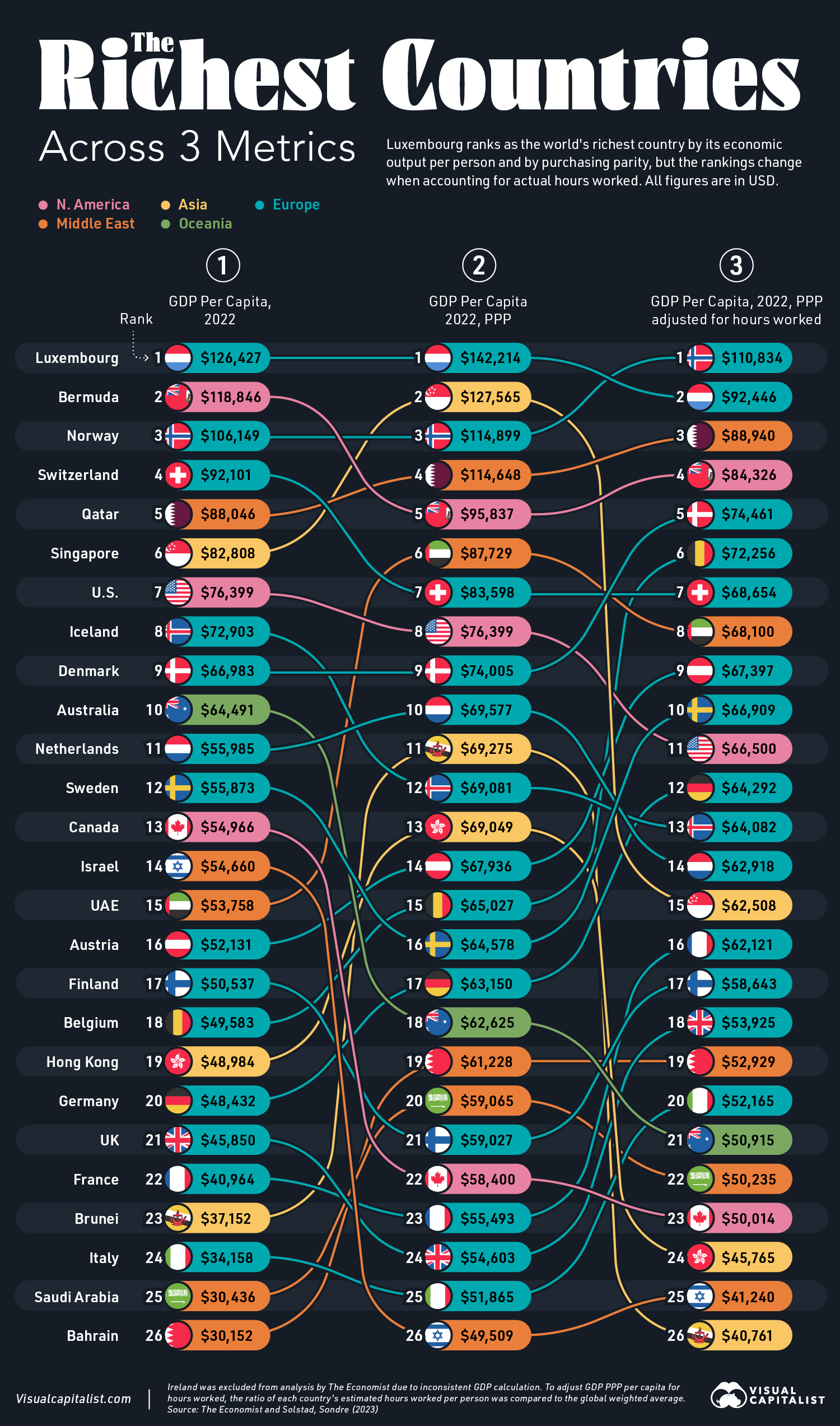By
Niccolo ConteHow do you measure the economic success of a country?
By one classic measure, GDP per capita shows individual economic prosperity. But comparing countries simply by this metric doesn’t tell the whole story. To get a better idea of living standards, it helps to look at how far your money will go along with adjusting for labor productivity.
This graphic shows the world’s richest countries by three different measures, based on data from The Economist and Sondre Solstad. All figures are in U.S. dollars.
World’s Richest Countries, by GDP per Capita
As the table below shows, smaller countries fare much better—of the top 10 richest countries, eight of them have populations under 10 million people.
Luxembourg, whose financial sector makes up 25% of its GDP, is the world’s richest country by GDP per capita.
With a population of just 660,000, the country is also considered a tax haven, incentivizing foreign investment due to its favorable tax policies. Due to the small nation’s considerable wealth, its citizens enjoy free education, healthcare, and transportation.
Bermuda, like Luxembourg, is known as a tax haven. Several multinationals shelter billions in the island nation—including Google, which moved $23 billion in a shell company in 2017 to lower foreign tax costs.
With a GDP per capita of $82,808, Singapore is the richest country in Asia thanks to its role as a global hub for finance, trade, and tourism.
A New Lens: Purchasing Power Parity (PPP)
Another way to compare countries adjusts GDP per capita based on the relative price of goods and services in order to account for differences in the cost of living and local currency strength.
This provides a clearer comparison of living standards across countries since the value of a dollar can buy more goods in different countries. Below, we show how countries perform differently based on this measure, known as GDP per capita adjusted by purchasing power parity (PPP):
As we can see, Singapore significantly jumps up the ranking, when adjusting for PPP.
Looking at the world’s richest countries this way shows that living standards are high in Singapore since their currency can go further than in other countries. Often, richer countries will have higher prices as a result of higher labor productivity, advanced technology, and other factors.
Similarly, the UAE rises into the top 10, outpacing both Switzerland and America. As one of the top oil-producing countries worldwide, it made $100 billion in oil revenues in 2022, equal to about $100,000 per citizen.
World’s Richest Countries, Adjusted for Hours Worked
How do the rankings change when accounting for productivity?
To analyze this, GDP per capita on a PPP basis is adjusted by the estimated hours worked per person. Economies that have high quality, productive workforces with strong standards of living tend to rank well using this measure.
In this case, Norway has the best ranking globally. This strong showing is likely influenced by working fewer hours compared to the American population due to greater holiday allowances, among other factors.
Meanwhile, the U.S. is in 11th place when adjusting for hours worked, with mainly Western European nations ahead in the ranking. Similarly, countries including the Netherlands, Singapore, Hong Kong, and Brunei drop when adjusting for working hours.
Importantly, the world’s richest countries can’t be understood by a single measure. It’s only by looking at a range of metrics that we can see how countries vary in the rankings depending on the measure and criteria chosen.
https://bitly.ws/3ecip










Комментариев нет:
Отправить комментарий